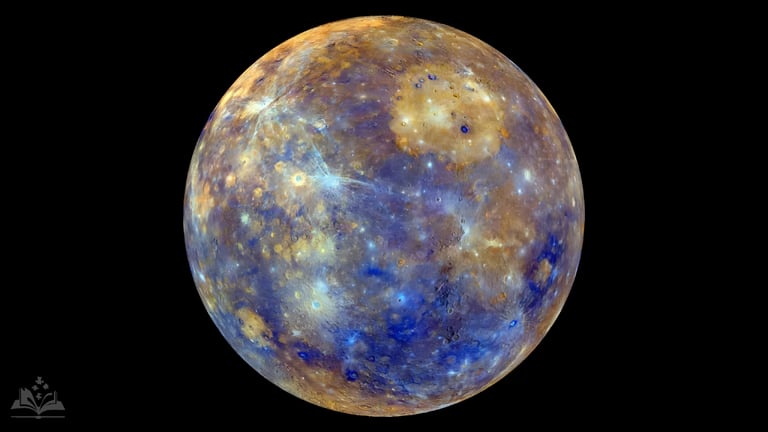
MESSENGER: Unlocking the Secrets of Mercury
Explore NASA’s MESSENGER mission, the first spacecraft to orbit Mercury, uncovering groundbreaking discoveries about its surface, magnetic field, water ice deposits, and more. Learn about its technology, scientific achievements, and lasting impact on planetary exploration.
SPACE MISSIONEDUCATION/KNOWLEDGEISRO/NASASPACE/TECH
Sachin K Chaurasiya
3/25/20254 min read


When it comes to exploring the planets of our Solar System, Mercury has always been one of the most mysterious. As the closest planet to the Sun, it endures extreme temperatures and harsh solar radiation. Yet, NASA’s MESSENGER (MErcury Surface, Space ENvironment, GEochemistry, and Ranging) mission changed the way we see this small but fascinating world. Launched in 2004, MESSENGER became the first spacecraft to orbit Mercury, revealing crucial details about its surface, atmosphere, and magnetic field.
Mission Overview
Launch Date: August 3, 2004
Earth Flyby: August 2, 2005
Venus Flybys: October 24, 2006 & June 5, 2007
Mercury Flybys: January 14, 2008; October 6, 2008; September 29, 2009
Orbital Insertion Around Mercury: March 18, 2011
End of Mission: April 30, 2015 (impact on Mercury’s surface)
MESSENGER took a complex trajectory, performing flybys of Earth, Venus, and Mercury to slow down enough for orbital capture. Once in orbit, it provided over four years of groundbreaking data before its planned impact on Mercury.
Key Scientific Discoveries
Mercury’s Water Ice Deposits
One of the most unexpected findings was the confirmation of water ice at Mercury’s poles. Even though surface temperatures can exceed 800°F (427°C), permanently shadowed craters in the north and south poles remain cold enough to preserve water ice. This discovery reshaped our understanding of how volatile elements survive in extreme environments.
Volcanic Activity and Surface Composition
MESSENGER revealed that Mercury was far more geologically active than previously thought. Large lava plains, pyroclastic deposits, and volcanic vents indicated extensive volcanic activity in the planet’s past. Additionally, the spacecraft found an unusually high concentration of sulfur, suggesting that Mercury’s interior chemistry is different from Earth’s or Mars’.
A Magnetic Field That’s Off-Center
Unlike Venus and Mars, which lack a global magnetic field, Mercury has one—but it’s weak and offset from the planet’s center by about 20% of Mercury’s radius. This suggests that the liquid core is still partially active, generating the field through a dynamo effect similar to Earth’s.
A Surprisingly Dynamic Exosphere
Mercury doesn’t have a traditional atmosphere but a thin exosphere made of sodium, potassium, calcium, and magnesium. MESSENGER found that solar radiation and micrometeorite impacts continuously replenish this fragile environment, influencing Mercury’s space weather.
Tectonic Activity and Shrinking Planet
MESSENGER provided clear evidence that Mercury is shrinking. The planet’s cooling interior has caused the surface to contract, creating massive cliffs (lobate scarps) that suggest ongoing tectonic activity.
Unusual Surface Features: Hollows
MESSENGER discovered hollows, strange, bright, irregular depressions that appear to be geologically young. These features suggest Mercury is still evolving and losing volatile materials through sublimation or other processes.
Iron-Rich Core and Thin Mantle
One of the most intriguing revelations was that Mercury has a huge iron-rich core, making up about 85% of the planet’s radius. The mantle and crust are much thinner than those of Earth, which gives clues to its formation history.


Technology Behind MESSENGER
MESSENGER was designed to withstand intense solar radiation while collecting high-resolution data. Some of its key technological innovations included:
Ceramic Sunshade: Protected the spacecraft from temperatures over 600°F (315°C).
Seven Science Instruments: Included cameras, spectrometers, a magnetometer, and laser altimeter for topographic mapping.
X-ray and Gamma-ray Spectrometers: Allowed detailed analysis of Mercury’s elemental composition.
Radio Science Experiment: Provided insights into Mercury’s gravity field and internal structure.
End of Mission: A Planned Impact
After completing its extended mission and running out of fuel, MESSENGER’s journey ended on April 30, 2015, when it crashed into Mercury’s surface at about 8,750 mph (14.080 km/h), creating a new crater. This was a planned impact, ensuring that the spacecraft maximized its scientific contributions until the very end.
The Legacy of MESSENGER
MESSENGER revolutionized our understanding of Mercury, providing over 277,000 images and 10 terabytes of data. Scientists are still analyzing its discoveries, and its findings will guide future missions, including the European-Japanese BepiColombo spacecraft, currently en route to Mercury. BepiColombo aims to build on MESSENGER’s discoveries by studying Mercury’s magnetic field, exosphere, and geological history in even greater detail.
Mercury and the Search for Life
While Mercury is not considered habitable due to its extreme temperatures and lack of a substantial atmosphere, the discovery of water ice in shadowed craters opens up interesting discussions about how water and volatiles are distributed in the Solar System. Studying Mercury can also help scientists understand exoplanets that orbit close to their stars, which may have similar extreme environments.
FAQs
What was the primary goal of the MESSENGER mission?
The MESSENGER mission aimed to study Mercury’s geology, magnetic field, exosphere, and surface composition, providing insights into the planet’s formation and evolution.
Why was it so difficult to send a spacecraft to Mercury?
Mercury’s proximity to the Sun makes it challenging to slow down a spacecraft due to the Sun’s gravitational pull. MESSENGER used multiple flybys of Earth, Venus, and Mercury to gradually adjust its speed for orbital insertion.
What were MESSENGER’s biggest scientific discoveries?
MESSENGER confirmed water ice in Mercury’s polar craters, discovered an offset magnetic field, revealed extensive volcanic activity, and found that Mercury is shrinking due to its cooling core.
How did MESSENGER survive Mercury’s extreme heat?
MESSENGER was equipped with a ceramic sunshade to protect its instruments from temperatures exceeding 600°F (315°C) while allowing uninterrupted scientific observations.
What happened to MESSENGER at the end of its mission?
After running out of fuel, MESSENGER crashed into Mercury’s surface on April 30, 2015, at a speed of 8,750 mph (14,080 km/h), creating a crater and marking the planned conclusion of the mission.
How did MESSENGER contribute to future missions?
The data collected by MESSENGER is guiding the BepiColombo mission, a joint effort by ESA and JAXA, which is currently en route to Mercury for further exploration.
What made Mercury’s magnetic field unique according to MESSENGER?
Unlike Earth’s centered magnetic field, Mercury’s is offset by about 20% of its radius, indicating an unusual internal dynamo process within its partially molten iron core.
MESSENGER’s mission was a testament to human ingenuity and curiosity. It defied expectations and deepened our knowledge of the Solar System’s least-explored rocky planet. Its discoveries about Mercury’s composition, magnetic field, and water ice will continue shaping planetary science for decades to come. With BepiColombo on its way, the exploration of Mercury is far from over, and the legacy of MESSENGER will remain a guiding light in our quest to understand the innermost planet of our Solar System.
Subscribe To Our Newsletter
All © Copyright reserved by Accessible-Learning Hub
| Terms & Conditions
Knowledge is power. Learn with Us. 📚


